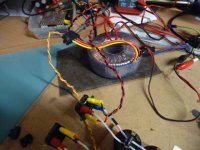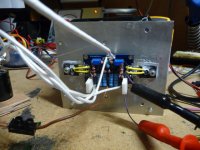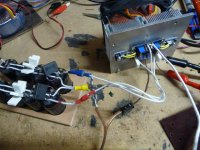the normal fuse value for a motor or transformer is 3 * watts / voltage.Is it OK one slow-blow 1.25A fuse to protect one F5? I am going dual psu for it, but Nelson Pass psu schematic doesn't specify if it is for one channel or two. I live in 230v. I will use the thermistors in the transformer.
If you implement soft start properly then that factor of 3 can be reduced to near 1times.
Due to the way we specify our audio PSUs. I have found that the factor can even be less than 1. I commonly use 0.8 * VA / voltage without incurring nuisance blowing when the soft start is scaled to suit the transformer VA.
I don't know the total wattage, so without more concrete advices, I will go with twice the recommended. I am not sure if 1.25A fuse will suffice for two F5 channels.
Regards,
regi
Regards,
regi
I've been looking for inside the official F5 thread but I couldn't found info about matching the jfets idss (2sk170 and 2sj74). Is there anything expected to gain, performance wise?
I have seen some BOMs that recommends to match them. I think that I have to find one 2sk170 and one 2sj74 with the same idss.
AFAIK, offset is adjusted by trimming pots, so I suspect that there should be small advantages in that sense.
Can anyone apport something to this?
I have almost all my components collected to start building, only need the jfets 🙂
Thank you very much to all,
Regards
I have seen some BOMs that recommends to match them. I think that I have to find one 2sk170 and one 2sj74 with the same idss.
AFAIK, offset is adjusted by trimming pots, so I suspect that there should be small advantages in that sense.
Can anyone apport something to this?
I have almost all my components collected to start building, only need the jfets 🙂
Thank you very much to all,
Regards
AFAIK, offset is adjusted by trimming pots, so I suspect that there should be small advantages in that sense.
Regards
It used to adjust the bias too.😀
Im really having hard time locating the panasonic 3w 0.47 resistors.
If anyone knows where can i find them.
Many Thanks !!!!
If anyone knows where can i find them.
Many Thanks !!!!
I get mine from Digikey. 3W panasonics
oh... 😱
I was sure that from digikey there was a limit order of 1500 pieces for this specific resistor.
My mistake.
Thank you !!!
some hum (?)
I experience some hum, or at least I think it is hum (some small multiple of 50Hz). one has to put his ear to speaker in order to hear the hum, but the target speaker is a 106DB sensitive one and the noise will be much more noticeable there. I measured the ripple of the rails while one channel is attached and properly biased (~0.59 Volts) on a scope and it is ~150mV peak to peak and similar on both rails. when the input is shorted to ground there is no noise at all. when the ground crocodile of the scope prob is attached, the nature of the noise changes.
Has anyone else experienced such noise?
one more odd thing - the rectifier bridge of the positive rail is getting hotter (by hand) than the negative one. I don't know what that hints.
Shmulik
I experience some hum, or at least I think it is hum (some small multiple of 50Hz). one has to put his ear to speaker in order to hear the hum, but the target speaker is a 106DB sensitive one and the noise will be much more noticeable there. I measured the ripple of the rails while one channel is attached and properly biased (~0.59 Volts) on a scope and it is ~150mV peak to peak and similar on both rails. when the input is shorted to ground there is no noise at all. when the ground crocodile of the scope prob is attached, the nature of the noise changes.
Has anyone else experienced such noise?
one more odd thing - the rectifier bridge of the positive rail is getting hotter (by hand) than the negative one. I don't know what that hints.
Shmulik
Attachments
Wire gauge for PD F5 boards
At Wdavis009:
The absolute largest wire you can use for power/output with the original PD F5 boards is 16-gauge stranded if you twist it up nice and tight.
At Wdavis009:
The absolute largest wire you can use for power/output with the original PD F5 boards is 16-gauge stranded if you twist it up nice and tight.
Hi,
when do you hear this low level Hum?
Only when no source is connected, or only when the input is shorted, or only when the input is open circuit, or a combination of these?
when do you hear this low level Hum?
Only when no source is connected, or only when the input is shorted, or only when the input is open circuit, or a combination of these?
Andrew, I understood from him that shorting input to ground ceases the noise.
Try to hook up your source and then measure, maybe having the inputs without a ground reference (nothing hooked up, free-air) brings out noise.
Regards,
Regi
Try to hook up your source and then measure, maybe having the inputs without a ground reference (nothing hooked up, free-air) brings out noise.
Regards,
Regi
Hum
the hum occurs when the input is in free air. still there is a pull down resistor just for that. I'll try hooking a source (output of opamp) and see what comes.
any ideas regarding the second strange thing - the unequal heating of the bridges?
the hum occurs when the input is in free air. still there is a pull down resistor just for that. I'll try hooking a source (output of opamp) and see what comes.
any ideas regarding the second strange thing - the unequal heating of the bridges?
that is a perfect way to reproduce music!the hum occurs when the input is in free air.
catching air
some reviewers use the tarm "air between instruments" when refering to sonic qualities. isn't the best way to catch that air is with no instruments to begin with? the rest follows.
seriously speaking, this hum haunts me. several of my DIY attempts ended humming. I even had a GainClone the was perfectly mute, and after returning from a friend cought up humming I failed to remove. I must be doing something profoundly wrong, but I can not spot it.
that is a perfect way to reproduce music!
some reviewers use the tarm "air between instruments" when refering to sonic qualities. isn't the best way to catch that air is with no instruments to begin with? the rest follows.
seriously speaking, this hum haunts me. several of my DIY attempts ended humming. I even had a GainClone the was perfectly mute, and after returning from a friend cought up humming I failed to remove. I must be doing something profoundly wrong, but I can not spot it.
if you leave the input open circuit you have effectively added a high impedance aerial to the amplifier.........seriously speaking, this hum haunts me. several of my DIY attempts ended humming. I even had a GainClone the was perfectly mute, and after returning from a friend cought up humming I failed to remove. I must be doing something profoundly wrong, but I can not spot it.
This is never the way you connect an amplifier to reproduce audio.
Me too, what's the difference with the boards in diyaudio store ?
D.
They are both F-5, just two different board layouts form two different sources.
The Daniels boards are more compact, the Cviller boards are a little larger.
There were originally some boards that later became available from Cviller as well, that had sufficient room for 4 out puts per channel, see his blog, and the group buy threads on both the Daniels and the Cviller boards for pics and building dicussion. They are both shorter than the gigantic F-5 thread, but it is certainly worth working through, take notes along the way.
Russellc
- Status
- Not open for further replies.
- Home
- Group Buys
- F5 pcb group buy...



